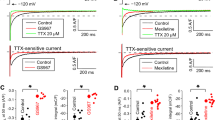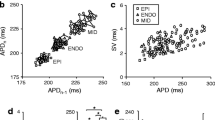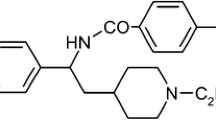Summary
Aprindine hydrochloride is a potent antiarrhythmic agent against various atrial and ventricular tachyarrhythmias. To elucidate its pharmacological actions in the atrioventricular node, electrophysiologic experiments were conducted by applying microelectrode and voltage clamp methods to small preparations of the rabbit atrioventricular node.
At a concentration 1 μmol/l, aprindine decreased the spontaneous firing frequency, maximal rate of depolarization, action potential amplitude, and take-off potential (P < 0.05, n = 7). The spontaneous and rate-controlled action potential durations at 50 and 100% repolarization were prolonged by aprindine. Voltage-clamp experiments using the double microelectrode method revealed that aprindine blocked the slow inward current (Isi) in a voltage-dependent manner with a dissociation constant of 10 μmol/l and Hill coefficient of 0.8. The steady-state inactivation curve for Isi was shifted toward more negative potentials by 2.5 ± 0.9 mV (P < 0.05, n = 5) without a significant change in the slope factor. This finding suggests that aprindine has a higher affinity for inactivated slow inward (or Ca2+) channels than for resting channels. Aprindine caused use-dependent block of Isi, a result consistent with the drug's slow dissociation from inactivated Ca2+ channels. The delayed rectifying K+ current (IK) tail obtained on repolarization from +10 mV to −60 mV was significantly decreased from 15.4 ± 2.4 to 6.8 ± 1.4 nA (P < 0.01, n = 6) and the deactivation time constant significantly increased by 20.7% (P < 0.01, n = 6). The steady-state activation curve for IK was shifted in the hyperpolarized direction by 6.9 ± 2.9 mV, suggesting a potent voltage-dependent block of this current by aprindine. The hyperpolarization-activated inward current (1h) was decreased from 14.4 ± 5.4 to 12.0 ± 5.5 nA (P < 0.05, n = 5). The transient outward and inward currents induced by 1 μmol/l acetylstrophanthidin were almost completely suppressed after the addition of 1 μmol/l aprindine.
These results suggest that aprindine exerts a negative chronotropic action both by slowing deactivation of IK and by reducing Is; and Ih, and delays atrioventricular nodal conduction by reducing Is; and IK. These blocking actions of aprindine together with its inhibition of the transient outward and inward currents may explain its antiarrhythmic effects on the atrioventricular node.
Similar content being viewed by others
References
Adams PC, Campbell RW, Julian DG (1984) The clinical pharmacology of antiarrhythmic drugs. Cardiovasc Clin 14:153–190
Arlock P, Katzung BG (1985) Effects of sodium substitutes on transient inward current and tension in guinea-pig and ferret papillary muscle. J Physiol (Loud) 360:105–120
Bean BP, Cohen CJ, Tsien RW (1983) Lidocaine block of cardiac sodium channels. J Gen Physiol 81:613–642
Carmeliet E, Verdonck F (1974) Effects of aprindine and lidocaine on transmembrane potentials and radioactive K efflux in different cardiac tissues. Acta Cardiol (Brux) 18:73–90
Colquhoun D, Neher E, Reuter H, Stevens CF (1981) Inward current channels activated by intracellular Ca in cultured cardiac cells. Nature 294:752–754
Cranefield PF (1977) Action potentials, after potentials, and arrhythmics. Circ Res 41:415–423
Elharrar V, Foster PR, Zipes DP (1975) Effects of aprindine HCl on cardiac tissues. J Pharmacol Exp Ther 195:201–205
Elharrar V, Bailey JC, Lathrop DA, Zipes DP (1978) Effects of aprindine HCl on slow channel action potentials and transient depolarizations in canine Purkinje fibres. J Pharmacol Exp Ther 205:410–417
Fasola AF, Carmichael R (1974) The pharmacology and clinical evaluation of aprindine, a new antiarrhythmic agent. Acta Cardiol (Brux) 18:317–333
Fasola AF, Noble RJ, Zipes DP (1977) Treatment of recurrent ventricular tachycardia and fibrillation with aprindine. Am J Cardiol 39:903–909
Ferrier GR, Moe GK (1973) Effects of calcium on acetylstrophanthidin-induced transient depolarizations in canine Purkinje tissue. Circ Res 33:508–515
Foster PR, King RM, Nicoll AB, Zipes DP (1976) Suppression of ouabain-induced ventricular rhythms with aprindine HCI. A comparison with other antiarrhythmic agents. Circulation 53: 315–321
Gilmour RF, Chikharev VN, Jurevichus JA, Zacharev SI, Zipes DP, Rosenshtraukh LV (1981) Effect of aprindine on transmembrane currents and contractile force in frog atria. J Pharmacol Exp Ther 217:390–396
Hille B (1977) Local anesthetics: hydrophilic and hydrophobic pathways for the drug-receptor reaction. J Gen Physiol 69:497–515
Hondeghem LM, Katzung BG (1977) Time- and voltage-dependent interactions of antiarrhythmic drugs with cardiac sodium channels. Biochim Biophys Acta 472:373–398
Kass RS, Lederer WJ, Tsien RW, Weingart R (1978a) Role of calcium ions in transient inward currents and aftercontractions induced by strophanthidin in cardiac Purkinje fibres. J Physiol (Lond) 281:187–208
Kass RS, Tsien RW, Weingart R (1978b) Ionic basis of transient inward current induced by strophanthidin in cardiac Purkinje fibres. J Physiol (Lond) 281:209–226
Kesteloot H, Van Mieghern W, DeGeest H (1973) Aprindine (AC 1802), a new anti-arrhythmic drug. Acta Cardiol (Brux) 28: 145–165
Kokubun S, Nishimura M, Noma A, Irisawa H (1982) Membrane currents in the rabbit atrioventricular node cell. Pflügers Arch 393:15–22
Kurachi Y, Nakajima T, Sugimoto T (1987) Quinidine inhibition of the muscarinic receptor-activated K+ channel current in atrial cells of guinea pig. Naunyn-Schmiedebergs Arch Pharmacol 335:216–218
Lee KS, Tsien RW (1983) Mechanisms of calcium channel blockade by verapamil, D600, diltiazem and nitrendipine in single dialysed heart cells. Nature 302:790–794
Mirro MJ, Manalan AS, Bailey JC, Watanabe AM (1980) Anticholinergic effects of disopyramide and quinidine on guinea pig myocardium. Mediation by direct muscarinic receptor blockade. Circ Res 47:855–865
Nakajima T, Kurachi Y, Ito H, Takikawa R, Sugimoto T (1989) Anti-cholinergic effects of quinidine, disopyramide, and procainamide in isolated atrial myocytes: mediation by different molecular mechanisms. Circ Res 64:297–303
Nakayama T, Kurachi Y, Noma A, Irisawa H (1984) Action potential and membrane currents of single pacemaker cells of the rabbit heart. Pflügers Arch 402:248–257
Nawrath H (1981) Action potential, membrane currents and force of contraction in mammalian heart muscle fibres treated with quinidine. J Pharmacol Exp Ther 216:176–182
Nawrath H, Sack U, Zong X (1984) Antimuscarinic action of quinidine on the heart? A study in myocardial preparations from cat hearts. Br J Pharmacol 81:103–111
Nishimura M, Habuchi Y, Hiromasa S, Watanabe Y (1988a) Ionic basis of depressed automaticity and conduction by acetylcholine in rabbit AV node. Am J Physiol 255:H7-H14
Nishimura M, Huan R-M, Habuchi Y, Tsuji Y, Nakanishi T, Watanabe Y (1988b) Membrane actions of quinidine sulfate in the rabbit atrioventricular node studied by voltage-clamp method. J Pharmacol Exp Ther 244:780–788
Nishimura M, Follmer CH, Singer DH (1989) Amiodarone blocks calcium current in guinea pig single ventricular myocyte. J Pharmacol Exp Ther 251:650–659
Noble D (1984) The surprising heart: A review of recent progress in cardiac electrophysiology. J Physiol (Lond) 353:1–50
Noma A, Kotake H, Irisawa H (1980) Slow inward current and its role mediating the chronotropic effect of epinephrine in the rabbit sinoatrial node. Pfliigers Arch 388:1–9
Steinberg MI, Greenspan K (1976) Intracellular electrophysiological alterations in canine cardiac conducting tissue induced by aprindine and lignocaine. Cardiovasc Res 10:236–244
TenEick RE, Yeh JZ, Robertson L (1980) Cellular electrophysiological effects of aprindine on cat papillary muscle. Fed Proc (abstr) 39:966
Uehara A, Hume JR (1985) Interactions of organic calcium channel antagonists with calcium channels in single frog atrial cells. J Gen Physiol 85621–647
Watanabe Y, Nishimura M, Tsuji Y (1984) Functions of the specialized conducting system and their regulation In: Abe H, Ito Y, Tada M eds.regulation of cardiac function. Japan Sci Soc Press, Tokyo and VNU Sci Press BVUtrecht, pp 315–326
Zipes DP, Gaum WE, Foster PR, Rosen KM, Wu D, Amat-y-leon F, Noble RJ (1977) Aprindine for treatment of supraventricular tachycardias. With particular application to Wolff-ParkinsonWhite syndrome. Am J Cardiol 40:586–596
Author information
Authors and Affiliations
Additional information
Send offprint requests to Yoshio Watanabe at the above address
Rights and permissions
About this article
Cite this article
Tanaka, H., Nishimura, M., Homma, N. et al. Electrophysiologic actions of aprindine in rabbit atrioventricular node. Naunyn-Schmiedeberg's Arch Pharmacol 341, 347–356 (1990). https://doi.org/10.1007/BF00180661
Received:
Accepted:
Issue Date:
DOI: https://doi.org/10.1007/BF00180661




